Application of Ground-Penetrating Radar and a Combined Penetrometer–Moisture Probe for Evaluating Spatial Distribution of Soil Moisture and Soil Hardness in Coastal and Inland Windbreaks
Abstract
1. Introduction
2. Materials and Methods
2.1. Study Site
2.2. CPMP Observations
2.3. GPR Surveys
- Dewow filtering.
- Gain correction using a linear function for the reflection time from 0 to 10 ns (1 dB at 0 ns and 30 dB at 10 ns) and a constant value of 30 dB for the reflection time longer than 10 ns.
- Filtering in wavenumber domain (minimum wavelength = 0.1 m, maximum wavelength = 10 m).
- Normal move out correction.
- Finite difference migration using V at each site (topography was also used at the CT site).
- Color table from white (minimum amplitude of −15 mV) to black (maximum amplitude of 15 mV).
- A horizontal drawing scale of 10 pixels m−1, and a vertical drawing scale of 200 pixels m−1.
3. Results
3.1. Comparison of θ Measured by the CPMP and the Gravimetric Method
3.2. Profiles of GPR Reflection and CPMP Measurements
4. Discussion
4.1. Applicability of a CPMP in Windbreaks
4.2. Applicability of GPR in Windbreaks
4.3. Combined Use of a CPMP and GPR to Evaluate Soil Moisture and Soil Hardness in Windbreaks
5. Conclusions
Author Contributions
Funding
Acknowledgments
Conflicts of Interest
References
- Zhu, J.J.; Gonda, Y.; Matsuzaki, T.; Yamamoto, M. Salt distribution in response to optical stratification porosity and relative windspeed in a coastal forest in Niigata, Japan. Agrofor. Syst. 2002, 56, 73–85. [Google Scholar] [CrossRef]
- Kathiresan, K.; Rajendran, N. Coastal mangrove forests mitigated tsunami. Estuar. Coast. Shelf Sci. 2005, 65, 601–606. [Google Scholar] [CrossRef]
- Torita, H.; Tanaka, N.; Masaka, K.; Iwasaki, K. Effects of forest management on resistance against tsunamis in coastal forests. Ocean Eng. 2018, 169, 379–387. [Google Scholar] [CrossRef]
- Kort, J. Benefits of windbreaks to field and forage crops. Agric. Ecosyst. Environ. 1988, 22–23, 165–190. [Google Scholar] [CrossRef]
- Iwasaki, K.; Torita, H.; Abe, T.; Uraike, T.; Touze, M.; Fukuchi, M.; Sato, H.; Iijima, T.; Imaoka, K.; Igawa, H. Spatial pattern of windbreak effects on maize growth evaluated by an unmanned aerial vehicle in Hokkaido, northern Japan. Agrofor. Syst. 2019, 93, 1133–1145. [Google Scholar] [CrossRef]
- Song, L.; Zhu, J.; Yan, Q.; Li, M.; Yu, G. Comparison of intrinsic water use efficiency between different aged Pinus sylvestris var. mongolica wide windbreaks in semiarid sandy land of northern China. Agrofor. Syst. 2015, 89, 477–489. [Google Scholar] [CrossRef]
- Antonellini, M.; Mollema, P.N. Impact of groundwater salinity on vegetation species richness in the coastal pine forests and wetlands of Ravenna, Italy. Ecol. Eng. 2010, 36, 1201–1211. [Google Scholar] [CrossRef]
- Oda, T. Study on the reaction of planted tree root systems to water-logging and its application to developing forests in damp lowlands of coastal sand dunes. Spec. Bull. Chiba Pref. For. Res. Center 2001, 3, 1–78. (In Japanese) [Google Scholar]
- Fukuchi, M.; Torita, H. The growth and survival of shelterbelts of Norway spruce (Picea abies) in central Hokkaido. Trans. Meet. Hokkaido Branch Jpn. For. Soc. 1996, 44, 17–19. (In Japanese) [Google Scholar]
- Hirano, Y.; Todo, C.; Yamase, K.; Tanikawa, T.; Dannoura, M.; Ohashi, M.; Doi, R.; Wada, R.; Ikeno, H. Quantification of the contrasting root systems of Pinus thunbergii in soils with different groundwater levels in a coastal forest in Japan. Plant Soil 2018, 426, 327–337. [Google Scholar] [CrossRef]
- Todo, C.; Tokoro, C.; Yamase, K.; Tanikawa, T.; Ohashi, M.; Ikeno, H.; Dannoura, M.; Miyatani, K.; Doi, R.; Hirano, Y. Stability of Pinus thunbergii between two contrasting stands at differing distances from the coastline. For. Ecol. Manag. 2019, 431, 44–53. [Google Scholar] [CrossRef]
- Shinomiya, Y.; Imaya, A.; Takanashi, K.; Sakamoto, T. The physical property of embankment with a rain pool: A case study of embankment built in the early stage of the Coastal Forest Restoration Project after tsunami. Bull. FFPRI 2016, 15, 151–159. (In Japanese) [Google Scholar]
- Ono, K.; Komoriya, A.; Tachibana, R.; Imaya, A.; Suzuki, S.; Noguchi, H.; Noguchi, K.; Hagino, H. Effects of row deep tillage for the growth base formed by piling up soil in damp lowlands behind coastal sand dunes to construct coastal disaster prevention forest belts on the Kujukuri coastline, Japan. Soil Sci. Plant Nutr. 2018, 64, 168–180. [Google Scholar] [CrossRef]
- Vaz, C.M.P.; Hopmans, J.W. Simultaneous measurement of soil penetration resistance and water content with a combined penetrometer–TDR moisture probe. Soil Sci. Soc. Am. J. 2001, 65, 4–12. [Google Scholar] [CrossRef]
- Topp, G.; Lapen, D.; Edwards, M.; Young, G. Laboratory calibration, in-field validation and use of a soil penetrometer measuring cone resistance and water content. Vadose Zone J. 2003, 2, 633–641. [Google Scholar] [CrossRef]
- Sun, Y.; Schulze Lammers, P.; Ma, D. Evaluation of a combined penetrometer for simultaneous measurement of penetration resistance and soil water content. J. Plant Nutr. Soil Sci. 2004, 167, 745–751. [Google Scholar] [CrossRef]
- Lin, C.P.; Tang, S.H.; Chung, C.C. Development of TDR penetrometer through theoretical and laboratory investigations: 1. Measurement of soil dielectric permittivity. Geotech. Test. J. 2006, 29, 306–313. [Google Scholar] [CrossRef]
- Kosugi, K.; Yamakawa, Y.; Masaoka, N.; Mizuyama, T. A combined penetrometer–moisture probe for surveying soil properties of natural hillslopes. Vadose Zone J. 2009, 8, 52–63. [Google Scholar] [CrossRef]
- Yamakawa, Y.; Kosugi, K.; Masaoka, N.; Tada, Y.; Mizuyama, T. Use of a combined penetrometer-moisture probe together with geophysical methods to survey hydrological properties of a natural slope. Vadose Zone J. 2010, 9, 768–779. [Google Scholar] [CrossRef]
- Masaoka, N.; Kosugi, K.; Yamakawa, Y.; Mizuyama, T.; Tsutsumi, D. Application of a combined penetrometer-moisture probe for investigating heterogeneous hydrological properties of a footslope area. Vadose Zone J. 2012, 11. [Google Scholar] [CrossRef]
- Yamakawa, Y.; Hotta, N.; Tsunetaka, H.; Ohsaka, O.; Masaoka, N.; Imaizumi, F.; Kosugi, K. Investigation of volcanic deposits using a combined penetrometer-moisture probe: Application in Izu-Oshima Volcano, Japan. Int. J. Eros. Control Eng. 2018, 11, 15–27. [Google Scholar] [CrossRef]
- Iwasaki, K.; Sato, H.; Masaka, K.; Torita, H.; Yamakawa, Y.; Kosugi, K. Use of a combined penetrometer-moisture probe for evaluating planting base of a coastal forest—A case study of Oshamambe, Hokkaido Prefecture. J. Jpn. Soc. Coast. For. 2016, 15, 39–43. (In Japanese) [Google Scholar]
- Hasegawa, S.; Tabata, M.; Kozawa, T.; Sato, Y. Relationship between physicality of soil and tree vigour in planting area maked by heavy construction machine—An example of high way planting area. J. Jpn. Inst. Landsc. Archit. 1984, 48, 104–122. (In Japanese) [Google Scholar] [CrossRef][Green Version]
- Sato, H.; Tsuda, T.; Kuramoto, S.; Iida, S.; Hashimoto, T. Recovery of soil penetration resistance on compacted skid trails after forest thinning in central Hokkaido. J. Jpn. For. Soc. 2018, 100, 110–115. (In Japanese) [Google Scholar] [CrossRef][Green Version]
- Bristow, C.S.; Pucillo, K. Quantifying rates of coastal progradation from sediment volume using GPR and OSL: The Holocene fill of Guichen Bay, south-east South Australia. Sedimentology 2006, 53, 769–788. [Google Scholar] [CrossRef]
- Igel, J.; Günther, T.; Kuntzer, M. Ground-penetrating radar insight into a coastal aquifer: The freshwater lens of Borkum Island. Hydrol. Earth Syst. Sci. 2013, 17, 519–531. [Google Scholar] [CrossRef]
- Gómez-Ortiz, D.; Martín-Crespo, T.; Rodríguez, I.; Sánchez, M.; Montoya, I. The internal structure of modern barchan dunes of the Ebro River Delta (Spain) from ground penetrating radar. J. Appl. Geophys. 2009, 68, 159–170. [Google Scholar] [CrossRef]
- Raper, R.L.; Asmussen, L.E.; Powell, J.B. Sensing hard pan depth with ground penetrating radar. Trans. ASAE 1990, 33, 41–46. [Google Scholar] [CrossRef]
- André, F.; Leeuwen, C.v.; Saussez, S.; Durmen, R.V.; Bogaert, P.; Moghadas, D.; Rességuier, L.d.; Delvaux, B.; Vereecken, H.; Lambot, S. High-resolution imaging of a vineyard in south of France using ground-penetrating radar, electromagnetic induction and electrical resistivity tomography. J. Appl. Geophys. 2012, 78, 113–122. [Google Scholar] [CrossRef]
- Kudou, K.; Nishikawa, H.; Fujii, H.; Asaka, T. Study on the interpretation of subsurface water environment to affect a growth condition of the shore forest using the property of electromagnetic reflectance property. J. Jpn. Soc. Civil Eng. Ser. G 2008, 64, 96–106. (In Japanese) [Google Scholar] [CrossRef]
- Doolittle, J.A.; Minzenmayer, F.E.; Waltman, S.W.; Benham, E.C.; Tuttle, J.W.; Peaslee, S.D. Ground-penetrating radar soil suitability map of the conterminous United States. Geoderma 2007, 141, 416–421. [Google Scholar] [CrossRef]
- Jol, H.M. Ground Penetrating Radar: Theory and Applications; Elsevier: Amsterdam, The Netherlands, 2009; p. 545. [Google Scholar]
- Lorenzo, H.; Pérez-Gracia, V.; Novo, A.; Armesto, J. Forestry applications of ground-penetrating radar. For. Syst. 2014, 19, 5–17. [Google Scholar] [CrossRef]
- Rejiba, F.; Bobée, C.; Maugis, P.; Camerlynck, C. GPR imaging of a sand dune aquifer: A case study in the niayes ecoregion of Tanma, Senegal. J. Appl. Geophys. 2012, 81, 16–20. [Google Scholar] [CrossRef]
- Doolittle, J.A.; Jenkinson, B.; Hopkins, D.; Ulmer, M.; Tuttle, W. Hydropedological investigations with ground-penetrating radar (GPR): Estimating water-table depths and local ground-water flow pattern in areas of coarse-textured soils. Geoderma 2006, 131, 317–329. [Google Scholar] [CrossRef]
- Masaka, K.; Torita, H.; Sato, H.; Kon, H.; Sato, H.; Fukuchi, M. Decline of Pinus thunbergii Parlat. stands due to excess soil moisture caused by a buried andosol layer at a coastal sand site in Hokkaido, northern Japan. J. For. Res. 2010, 15, 341–346. [Google Scholar] [CrossRef]
- Topp, G.C.; Davis, J.L.; Annan, A.P. Electromagnetic determination of soil water content: Measurements in coaxial transmission lines. Water Resour. Res. 1980, 16, 574–582. [Google Scholar] [CrossRef]
- Subedi, S.; Kawamoto, K.; Karunarathna, A.K.; Moldrup, P.; Wollesen de Jonge, L.; Komatsu, T. Mini tensiometer-time domain reflectometry coil probe for measuring soil water retention properties. Soil Sci. Soc. Am. J. 2013, 77, 1517–1528. [Google Scholar] [CrossRef]
- Katsura, S.; Kosugi, K.; Mizuyama, T. Application of a coil-type TDR probe for measuring the volumetric water content in weathered granitic bedrock. Hydrol. Process. 2008, 22, 750–763. [Google Scholar] [CrossRef]
- Kim, J.H. RADPRO V.3.4 User’s Guide; KIGAM: Daejeon, Korea, 2004; p. 84. [Google Scholar]
- Schneider, C.A.; Rasband, W.S.; Eliceiri, K.W. NIH Image to ImageJ: 25 years of image analysis. Nat. Methods 2012, 9, 671–675. [Google Scholar] [CrossRef]
- Kowalsky, M.B.; Dietrich, P.; Teutsch, G.; Rubin, Y. Forward modeling of ground-penetrating radar data using digitized outcrop images and multiple scenarios of water saturation. Water Resour. Res. 2001, 37, 1615–1625. [Google Scholar] [CrossRef]
- Lunt, I.A.; Hubbard, S.S.; Rubin, Y. Soil moisture content estimation using ground-penetrating radar reflection data. J. Hydrol. 2005, 307, 254–269. [Google Scholar] [CrossRef]
- Jonard, F.; Mahmoudzadeh, M.; Roisin, C.; Weihermüller, L.; André, F.; Minet, J.; Vereecken, H.; Lambot, S. Characterization of tillage effects on the spatial variation of soil properties using ground-penetrating radar and electromagnetic induction. Geoderma 2013, 207–208, 310–322. [Google Scholar] [CrossRef]
- Bano, M. Effects of the transition zone above a water table on the reflection of GPR waves. Geophys. Res. Lett. 2006, 33, 1–5. [Google Scholar] [CrossRef]
- Tanikawa, T.; Ikeno, H.; Dannoura, M.; Yamase, K.; Aono, K.; Hirano, Y. Leaf litter thickness, but not plant species, can affect root detection by ground penetrating radar. Plant Soil 2016, 408, 271–283. [Google Scholar] [CrossRef]
- Harari, Z. Ground-penetrating radar (GPR) for imaging stratigraphic features and groundwater in sand dunes. J. Appl. Geophys. 1996, 36, 43–52. [Google Scholar] [CrossRef]
- Wang, P.; Hu, Z.; Zhao, Y.; Li, X. Experimental study of soil compaction effects on GPR signals. J. Appl. Geophys. 2016, 126, 128–137. [Google Scholar] [CrossRef]
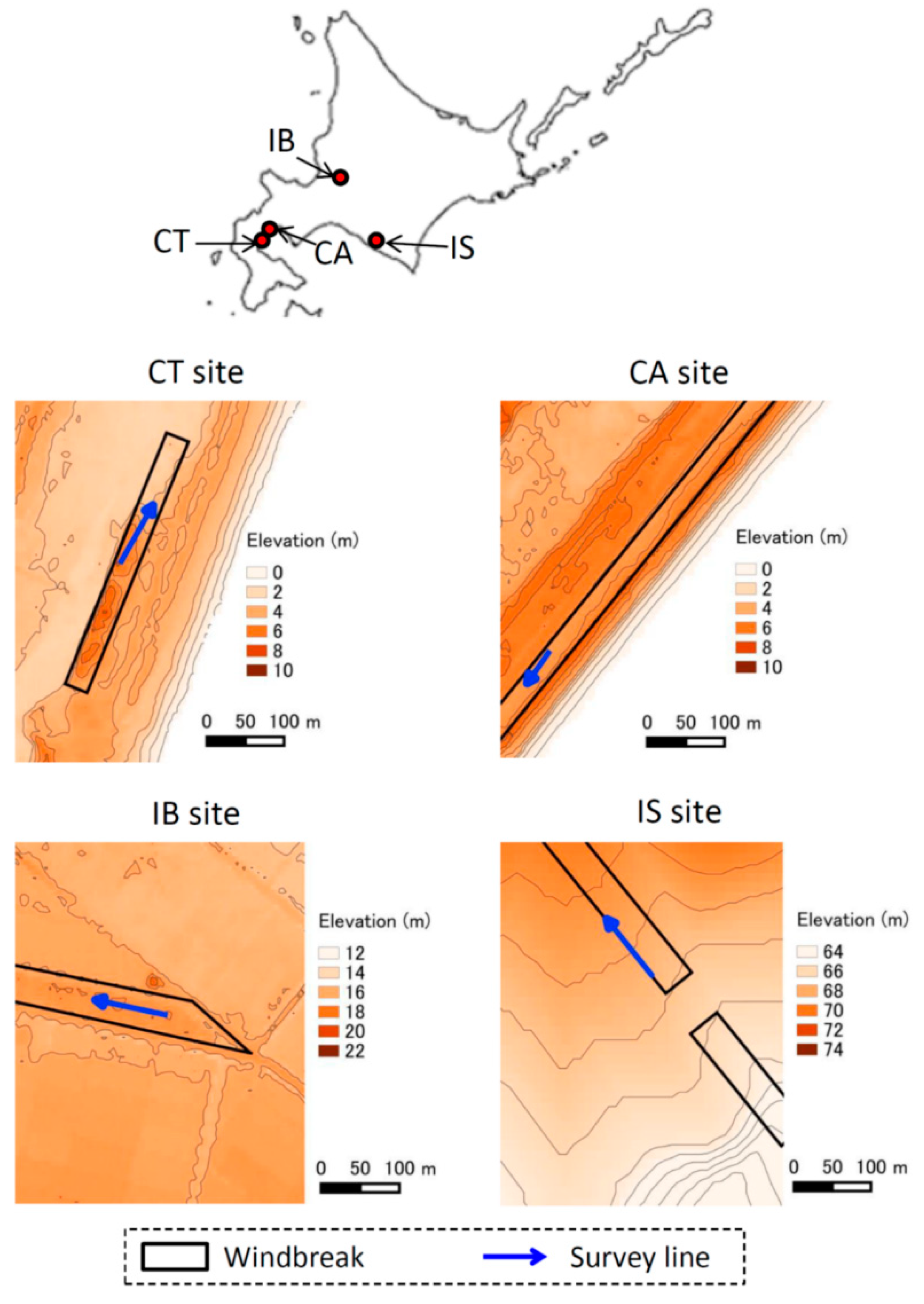
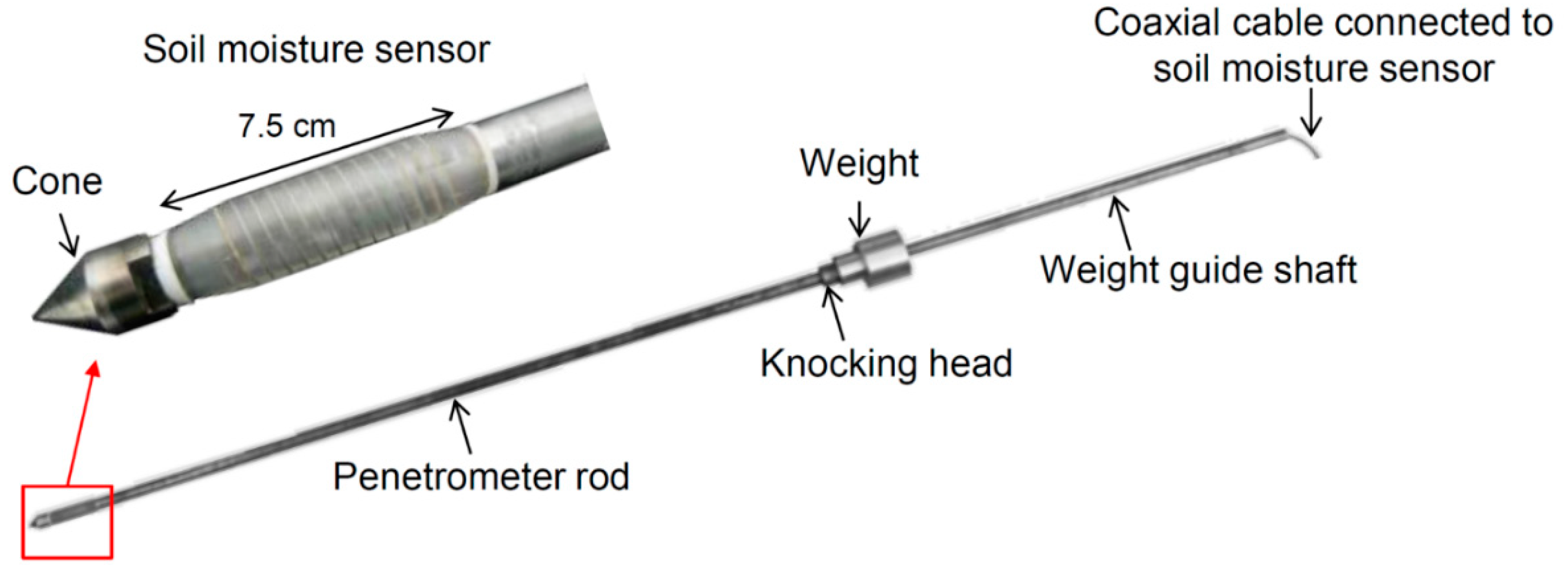

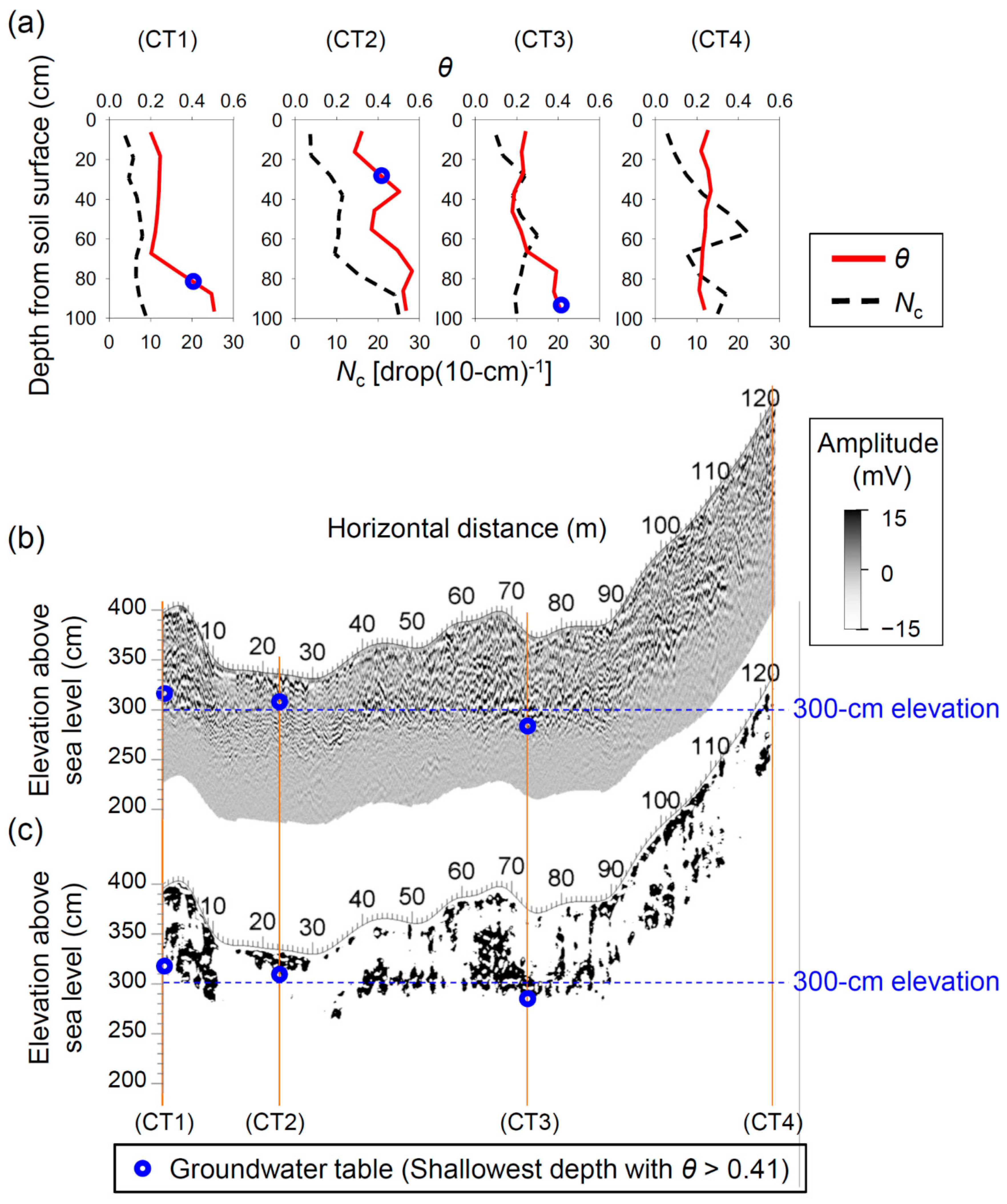
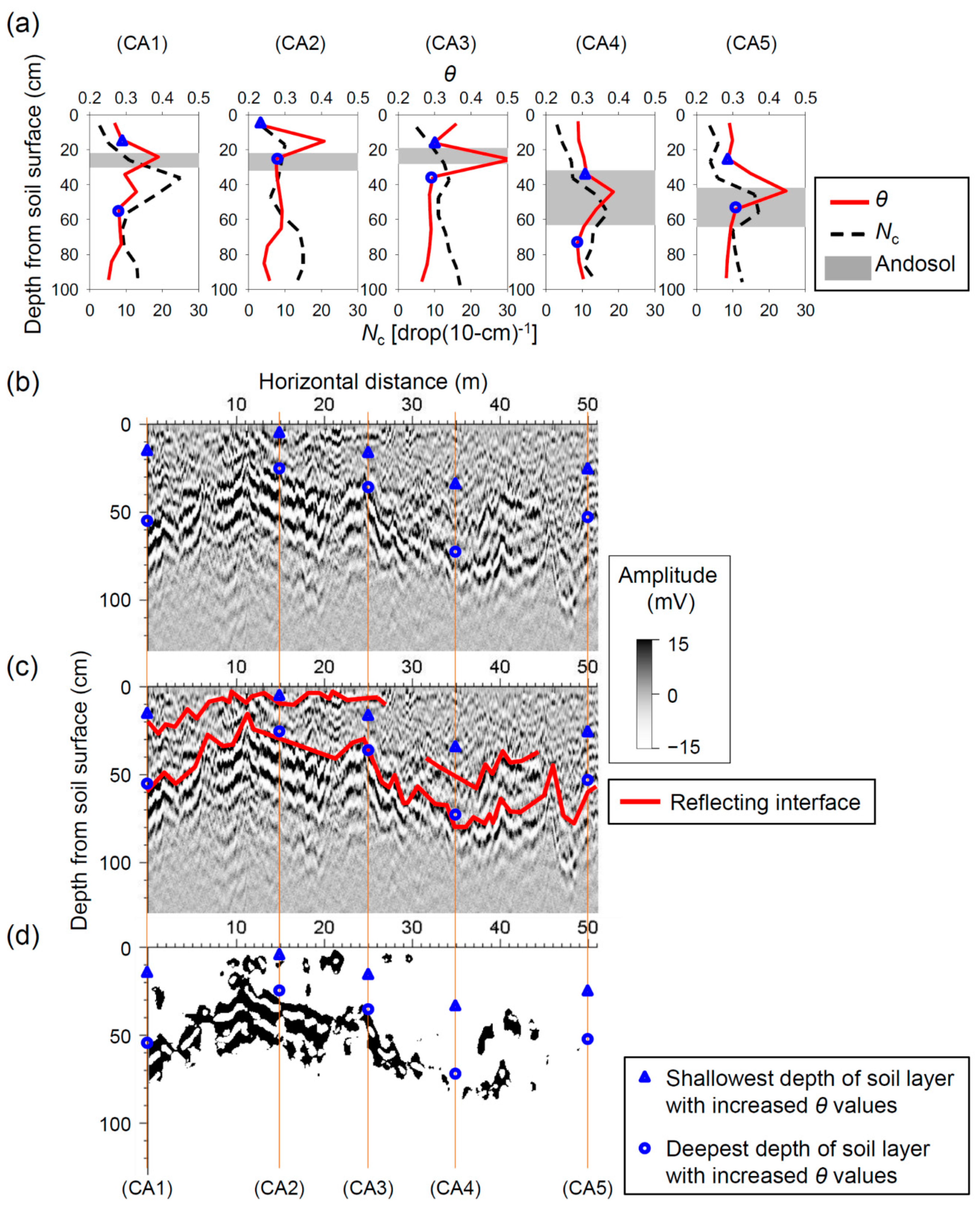
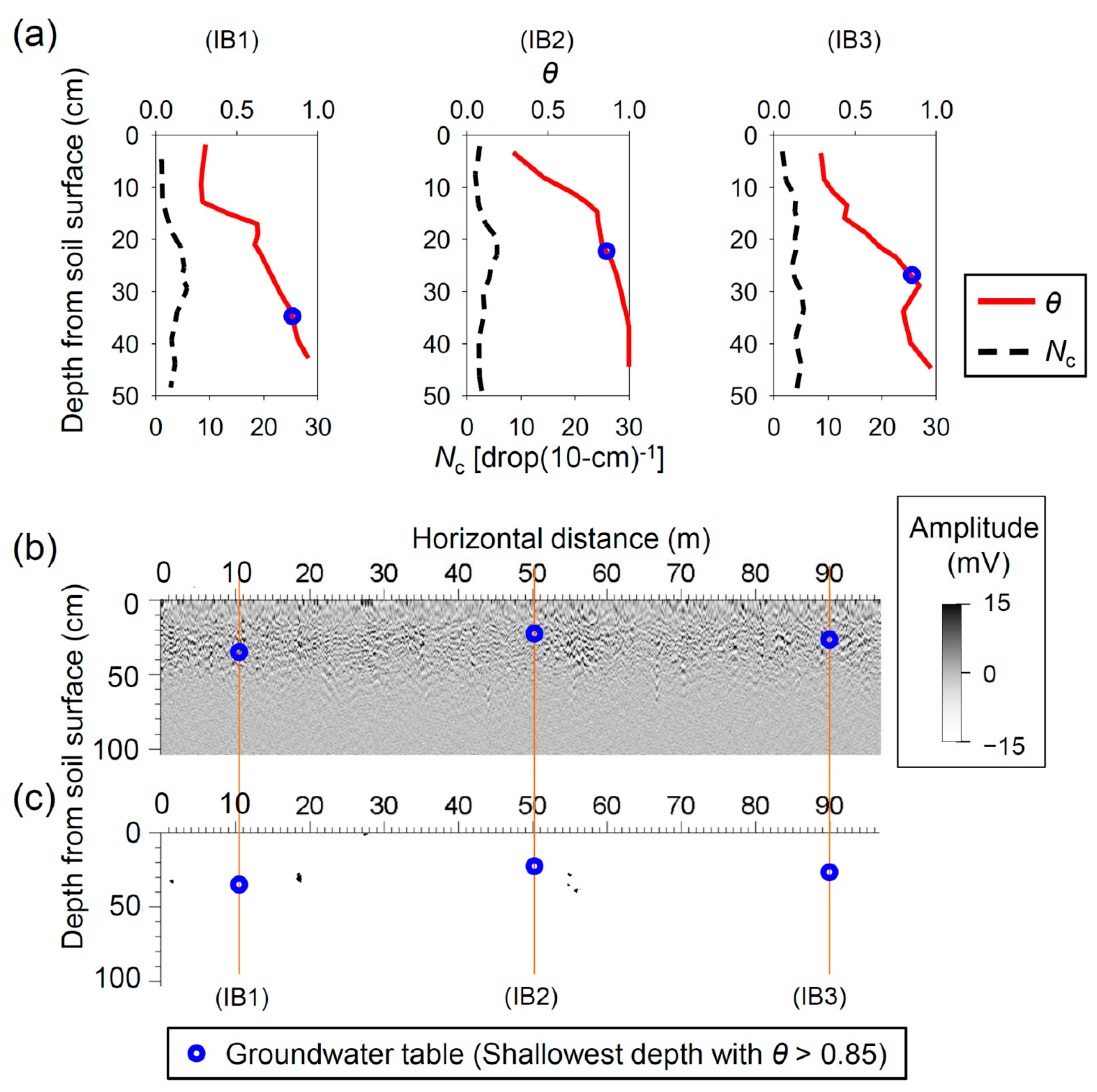
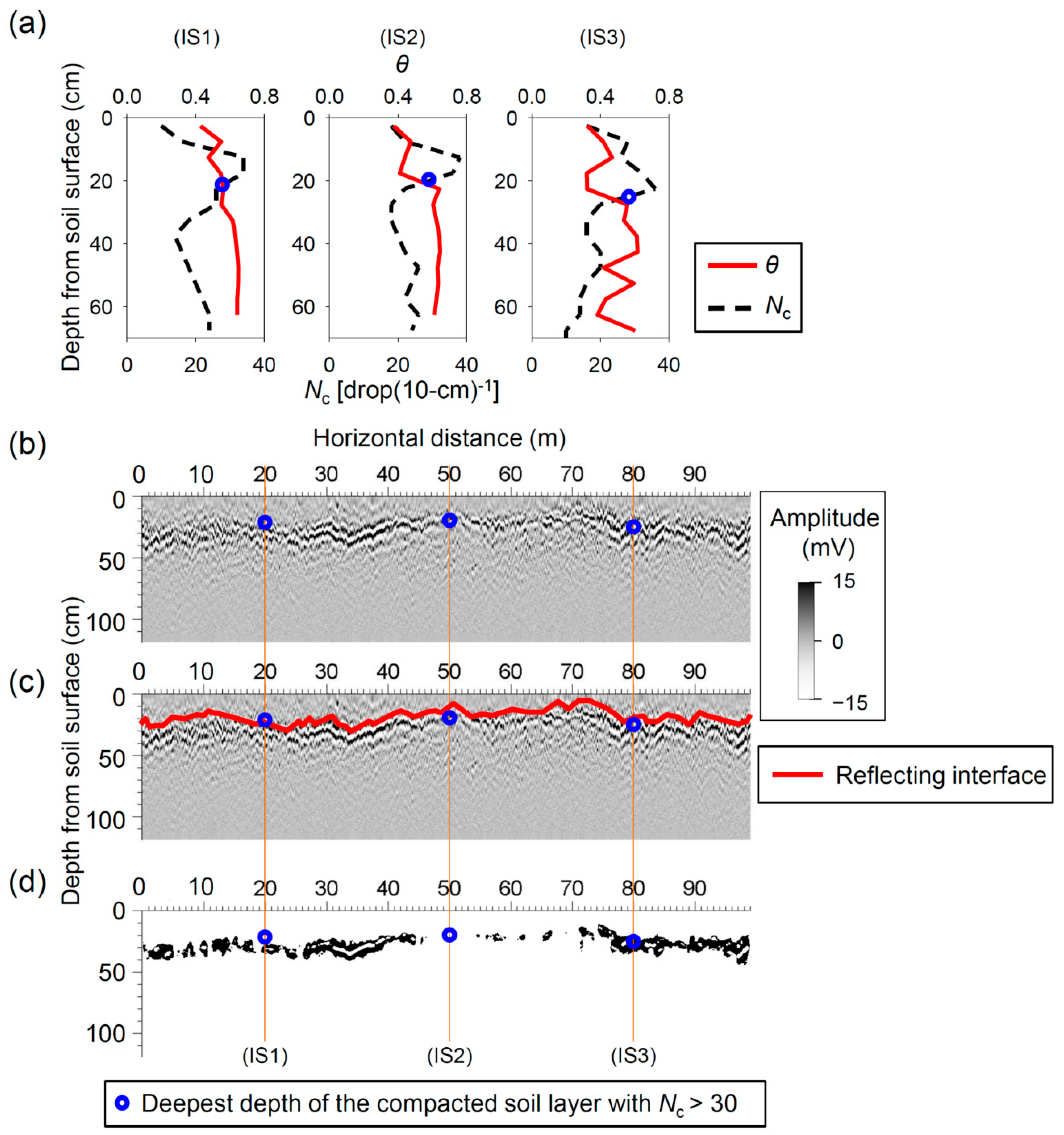
| Site | GPR Survey and Simultaneous CPMP Observations | Verification Date | ||
|---|---|---|---|---|
| Observation Date | Antecedent Precipitation (1 Day) (mm) | Antecedent Precipitation (1 Week) (mm) | ||
| CT | 26 October 2015 | 0.5 | 34.5 | 23 October 2013 26 October 2015 |
| CA | 27 October 2015 | 0.0 | 28.0 | 27 October 2015 |
| IB | 7 June 2016 | 0.0 | 47.5 | 7 June 2016 8 May 2019 |
| IS | 20 October 2016 | 5.0 | 6.0 | 14 November 2018 |
© 2020 by the authors. Licensee MDPI, Basel, Switzerland. This article is an open access article distributed under the terms and conditions of the Creative Commons Attribution (CC BY) license (http://creativecommons.org/licenses/by/4.0/).
Share and Cite
Iwasaki, K.; Tamura, M.; Sato, H.; Masaka, K.; Oka, D.; Yamakawa, Y.; Kosugi, K. Application of Ground-Penetrating Radar and a Combined Penetrometer–Moisture Probe for Evaluating Spatial Distribution of Soil Moisture and Soil Hardness in Coastal and Inland Windbreaks. Geosciences 2020, 10, 238. https://doi.org/10.3390/geosciences10060238
Iwasaki K, Tamura M, Sato H, Masaka K, Oka D, Yamakawa Y, Kosugi K. Application of Ground-Penetrating Radar and a Combined Penetrometer–Moisture Probe for Evaluating Spatial Distribution of Soil Moisture and Soil Hardness in Coastal and Inland Windbreaks. Geosciences. 2020; 10(6):238. https://doi.org/10.3390/geosciences10060238
Chicago/Turabian StyleIwasaki, Kenta, Makoto Tamura, Hirokazu Sato, Kazuhiko Masaka, Daisuke Oka, Yosuke Yamakawa, and Ken’ichirou Kosugi. 2020. "Application of Ground-Penetrating Radar and a Combined Penetrometer–Moisture Probe for Evaluating Spatial Distribution of Soil Moisture and Soil Hardness in Coastal and Inland Windbreaks" Geosciences 10, no. 6: 238. https://doi.org/10.3390/geosciences10060238
APA StyleIwasaki, K., Tamura, M., Sato, H., Masaka, K., Oka, D., Yamakawa, Y., & Kosugi, K. (2020). Application of Ground-Penetrating Radar and a Combined Penetrometer–Moisture Probe for Evaluating Spatial Distribution of Soil Moisture and Soil Hardness in Coastal and Inland Windbreaks. Geosciences, 10(6), 238. https://doi.org/10.3390/geosciences10060238





